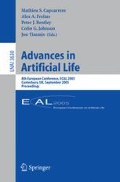Abstract
The Synapsing Variable Length Crossover (SVLC) algorithm provides a biologically inspired method for performing meaningful crossover between variable length genomes. In addition to providing a rationale for variable length crossover it also provides a genotypic similarity metric for variable length genomes enabling standard niche formation techniques to be used with variable length genomes. Unlike other variable length crossover techniques which consider genomes to be rigid inflexible arrays and where some or all of the crossover points are randomly selected, the SVLC algorithm considers genomes to be flexible and chooses non-random crossover points based on the common parental sequence similarity. The SVLC Algorithm recurrently “glues” or synapses homogenous genetic sub-sequences together. This is done in such a way that common parental sequences are automatically preserved in the offspring with only the genetic differences being exchanged or removed, independent of the length of such differences. In a variable length test problem the SVLC algorithm is shown to outperform current variable length crossover techniques.The SVLC algorithm is also shown to work in a more realistic robot neural network controller evolution application.
Access this chapter
Tax calculation will be finalised at checkout
Purchases are for personal use only
Preview
Unable to display preview. Download preview PDF.
References
Goldberg, D., Deb, K., Korb, B.: Messy genetic algorithms: motivation, analysis, and first results. Complex Systems 3, 493–530 (1989)
Fullmer, B., Miikkulainen, R.: Using Marker-Based Genetic Encoding of Neural Networks to evolve Finite-State Behaviour. In: Varela, F., Bourgine, P. (eds.) Proceedings of the First European Conference on Artificial Life. MIT Press, Cambridge (1991)
Koza, J.: A paradigm for genetically breeding computer programs to solve problems. Technical Report STAN-CS-90-1314, Department of Computer Science. Stanford University (1990)
Lee, C., Antonsson, E.: Variable Length Genomes for Evolutionary Algorithms. In: Proceedings of the Genetic and Evolutionary Computation Conference, p. 806. Morgan Kaufmann, San Francisco (2000)
Harvey, I.: The SAGA Cross: the mechanics of crossover for variable-length genetic algorithms. In: Männer, R., Manderick, B. (eds.) Parallel Problem Solving from Nature, vol. 2, pp. 269–278 (1992)
Burke, D., De Jong, K., Grefenstette, J., Ramsey, C., Wu, A.: Putting More Genetics into Genetic Algorithms. In: Whitley, D. (ed.) Evolutionary Computation, vol. 6(4), pp. 387–410 (1998)
Kimball, J.: Biology. McGraw Hill Education, New York (1994)
Harvey, I.: Species adaptation genetic algorithms: a basis for a continuing SAGA. In: Varela, F., Bourgine, P. (eds.) Proceedings of the First European Conference on Artificial Life, pp. 346–354. MIT Press, Cambridge (1992)
Harvey, I.: Artificial Evolution: A Continuing SAGA. In: Gomi, T. (ed.) ER-EvoRob 2001. LNCS, vol. 2217, p. 94. Springer, Heidelberg (2001)
Hutt, B.: Evolving Artificial Neural Network Controllers for Robots using Species Based Methods. PhD Thesis, Department of Cybernetics, School of Systems Engineering, The University of Reading (2002)
Langdon, W., Poli, R.: Fitness Causes Bloat. In: Proceedings of the Second On-line World Conference on Soft Computing in Engineering Design and Manufacturing (1997)
Author information
Authors and Affiliations
Editor information
Editors and Affiliations
Rights and permissions
Copyright information
© 2005 Springer-Verlag Berlin Heidelberg
About this paper
Cite this paper
Hutt, B., Warwick, K. (2005). Synapsing Variable Length Crossover: An Algorithm for Crossing and Comparing Variable Length Genomes. In: Capcarrère, M.S., Freitas, A.A., Bentley, P.J., Johnson, C.G., Timmis, J. (eds) Advances in Artificial Life. ECAL 2005. Lecture Notes in Computer Science(), vol 3630. Springer, Berlin, Heidelberg. https://doi.org/10.1007/11553090_93
Download citation
DOI: https://doi.org/10.1007/11553090_93
Publisher Name: Springer, Berlin, Heidelberg
Print ISBN: 978-3-540-28848-0
Online ISBN: 978-3-540-31816-3
eBook Packages: Computer ScienceComputer Science (R0)

